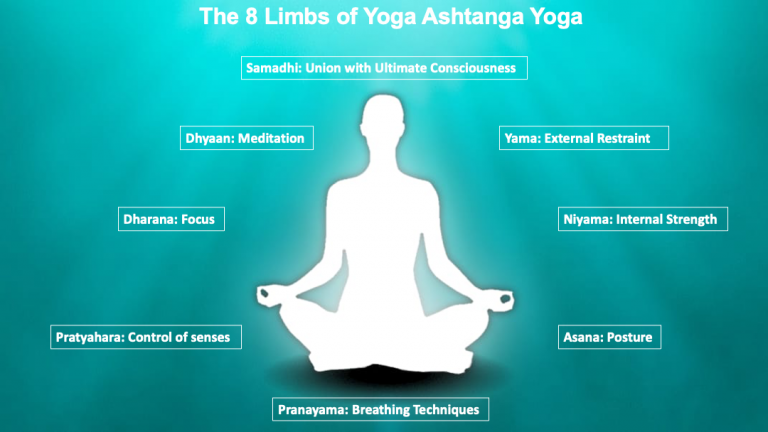
The goal of Sadhana is to focus the mind, calm its restlessness and control its fluctuations. Only when complete control of the mind is achieved can one catch a glimpse of the Almighty and become one with him. When this oneness is achieved, all despair fades away, all restrictions are removed, and one attains complete and absolute knowledge. The uncontrolled mind is the cause of conflict in the soul and intellect. The soul, affected by the restless mind, forgets it’s true nature of being a drishta or observer. It starts considering itself as the karta or doer of acts, and gets entangled in the pleasant or unpleasant results of these acts. This becomes a source of pain for the soul. The goal of sadhana or a spiritual practice is to remove this illusion and to show the soul it’s true self. When the soul acquires this knowledge of, and starts experiencing it’s true self, it becomes satisfied and peace ensues. Patanjali also wrote ‘Vritti sarupyam itaratra’ : When one is not in self-realization, the person takes on the identity of the fluctuations of mind (thought patterns). That is, when we are wrapped up in our thoughts, unable to stay present, we become our thoughts.
Sadhana is the process by which the fluctuations of the mind are controlled, and one achieves the goal of being one with God.
Different types of Sadhana or practices:
People are very different from one another. Everyone has their thoughts, expressions, actions, likes, abilities, and cultural values. Even within the same family, personal traits can vary widely. The same type of spiritual practice cannot appeal to all individuals. That is the reason that multiple spiritual pathways exist. These various spiritual practices can be broadly categorized into three different types.
The practices that emphasize control of the senses, the mind’s alignment with the body, and where the individual considers himself the ‘doer’ are called ‘Karma Yoga’. Hatha Yoga, Tantra Yoga, Japa Yoga, and the practice of yoga asanas are examples of ‘Karma Yog’.
The second category is Upasana Yoga, which just involves controlling and focusing the mind. There are no other physical efforts involved, and the person does not consider himself the ‘doer’. Meditation, concentration, and control of the mind are the mainstays of this method.
The third category of spiritual practices that one comes across falls under ‘Gyan Yoga’ These involve using the intellect after the calming of the mind. Self-study, Satsang, and use of the acquired wisdom are included under ‘Gyan Yoga’.
These three types of practices take a person to a point beyond which there is just Prem Yog and Samarpan Yog, which are synonymous with being one with the almighty.
Of these three types of spiritual practices described above, Upasana Yog seems to be the best because it can help one attain their goal most expeditiously while being simple to perform. Karma Yoga requires a lot of hard work, and it is very time-consuming. The Yogas like Shath Yoga, Kundalini Yoga, Tantra Yoga, and Hatha Yoga, to name a few, are also quite difficult to perform, and not everyone can withstand these extreme physical penances. Many develop physical and mental ailments while on this path. Others spend most of their life trying to master these, and the actual goal of realizing God remains distant.
Similarly, Vivek Yoga or Gyan Yoga is also a difficult path to follow. It is easy to learn and talk about something, but it is an entirely different matter and quite difficult to actually become what one is talking about. When the time comes, one may realize that one’s life could not really become what they wanted it to turn out to be. They may find that though they really wanted to, they could not really succeed in aligning their mind and intellect with the knowledge and thoughts that they had acquired. Swami Shankaracharya has said that to acquire the knowledge of the Vedantas, one must first master four different areas called the ‘Saadhan chatushtay’. These are Sham, Dama, Titiksha and Uparama. Sham means calmness of the mind. Dama implies control over the senses. Titiksha is tolerance, and Uparama means withdrawing from the world. Only after mastering these four areas can one achieve success with Vivek Yoga or Gyan Yoga.
That is why I say that Upasana Yoga is simpler to follow, yields faster results, and, therefore, especially useful in today’s day and age.
The practice of Upasana:
The three pillars of Upasana Yoga are- Dhaaranaa, Dhyaan, and Pratyahar.
In this practice of Upasana, one has to turn one’s attention inwards. One has to try to free oneself from one’s stresses and worries and focus on the divine light in the area of one’s heart. According to Maharishi Patanjali, this is called ‘Vishoka va jyotishmati’ meaning that one can attain tranquility by fixing the mind on the inner divine light, which is beyond pain, suffering, and sorrow. A Guru can modify this concept based on his experience.
To focus the mind on one goal is called Dhaarana. When the practitioner is immersed in the thought of achieving the goal to such an extent that he even forgets what his goal is, then Dhaarana transitions into Dhyaan. When the mind wanders away and gets distracted, refocusing it to concentrate on the original goal is called Pratyahara. Repeated practice of refocusing one’s wandering mind on a single goal successfully establishes the foundation of Dhaarana. The next step of Dhyaan is built over it. Steadfastness in dhyaan delivers one into the realm of Upasana.
This is a translation from Sadhana Ke Anubhav (Experiences in Spiritual Practice) written by Dr. Chaturbhuj Sahay Ji. #volume 1


